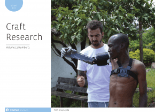
Craft Research
Scope & Guideline
Illuminating Craft Practices: A Hub for Innovative Research
Introduction
Aims and Scopes
- Cultural Significance of Craft:
The journal emphasizes the importance of craft as a medium for cultural expression, heritage preservation, and community identity, often exploring how crafts reflect and shape societal values. - Material and Methodological Exploration:
A significant focus is placed on the exploration of materials and techniques in craft-making, including experimental approaches and the integration of technology in traditional crafts. - Interdisciplinary Approaches:
Craft Research encourages interdisciplinary studies, combining perspectives from art, design, sociology, anthropology, and environmental studies to enrich the understanding of craft. - Sustainability and Ethical Practices:
The journal investigates sustainable practices within the craft sector, focusing on eco-friendly materials, ethical labor practices, and the role of crafts in promoting social change. - Education and Learning in Craft:
There is an ongoing interest in craft education, examining pedagogical approaches, community learning, and the significance of crafting skills in various educational settings.
Trending and Emerging
- Sustainability and Environmental Awareness:
Recent publications highlight an increasing emphasis on sustainability, examining how crafts can contribute to environmental awareness and promote sustainable practices within communities. - Social and Political Engagement:
There is a growing trend towards exploring the role of craft in social activism and political engagement, with studies focusing on crafts as tools for community building and addressing social justice issues. - Exploration of Identity and Intersectionality:
Emerging themes include explorations of identity, gender, and cultural narratives within craft practices, reflecting broader societal discussions on diversity and representation. - Technology Integration in Craft:
The integration of technology into craft practices is a rising theme, with investigations into digital fabrication, virtual collaborations, and the impact of technology on traditional craft methods. - Craft as a Means of Wellbeing:
The therapeutic aspects of craft-making and its role in promoting mental health and community well-being are increasingly recognized, reflecting a broader societal interest in the benefits of hands-on, creative activities.
Declining or Waning
- Traditional Craft Techniques:
There appears to be a waning focus on purely traditional craft techniques, with more emphasis shifting towards contemporary interpretations and innovative practices that blend traditional skills with modern methodologies. - Craft as Solely Decorative Art:
The journal has seen a decline in the exploration of craft primarily as decorative art, moving towards themes that emphasize function, social engagement, and the conceptual underpinnings of craft practices. - Historical Craft Studies:
Research centered on historical analysis of craft practices has become less prevalent, as the journal increasingly prioritizes contemporary issues and the current relevance of craft in society.
Similar Journals

CONNAISSANCE DES ARTS
Exploring the Depths of Visual and Performing ArtsCONNAISSANCE DES ARTS, published by SFPA-CONNAISSANCE ARTS, is a prominent French journal that has been enriching the landscape of Visual Arts and Performing Arts since its inception in 1969. With an ISSN of 0293-9274, this journal offers a platform for critical exploration and scholarly discourse, making notable contributions especially in the realms of art history, criticism, and contemporary artistic practices. Although the journal currently holds a Q4 quartile ranking in its category and ranks in the lower echelon of Scopus ranks (#638 out of 667), its focus on niche topics within the arts makes it a valuable resource for researchers and professionals who seek to engage with less mainstream topics that often go overlooked. The journal publishes insightful articles, reviews, and essays, contributing to the nurturing of artistry and culture in France and beyond. While it is not an open-access publication, the journal remains a significant entity for academics and practitioners keen on advancing their understanding of visual and performing arts. For further engagement with the journal, interested parties can reach out or submit inquiries to its address at 51 RUE VIVIENNE, 75095 PARIS CEDEX 02, FRANCE.

Journal of Modern Craft
Innovating Discourse in Visual and Performing ArtsWelcome to the Journal of Modern Craft, a premier platform dedicated to advancing discourse and scholarship in the field of contemporary craft practices. Published by Routledge Journals, Taylor & Francis Ltd, this academic journal boasts an ISSN of 1749-6772 and an E-ISSN of 1749-6780, reflecting its commitment to accessibility and dissemination within a global academic community. With an impactful focus on Visual Arts and Performing Arts, the journal has been consistently engaging researchers, practitioners, and students since its inception in 2011, currently converging its insights to explore trends up until 2024. Although it holds a Q4 ranking in the 2023 category quartiles and a Scopus rank of 430/667, thus placing it in the 35th percentile, the journal remains a vital resource for critical analysis, innovative methods, and emerging thoughts within the craft sector. Its unique approach encourages interdisciplinary dialogue, making it an essential read for anyone invested in the nuances of modern craft. Embrace the opportunity to contribute and engage with meaningful research in this evolving field.
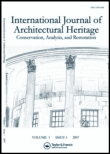
International Journal of Architectural Heritage
Illuminating Trends, Inspiring Preservation.The International Journal of Architectural Heritage is a premier publication dedicated to the multidisciplinary fields of architecture, conservation, and visual arts. Published by TAYLOR & FRANCIS INC, this journal serves as a vital platform for scholars and practitioners who aim to advance knowledge in the preservation of cultural heritage and architectural innovation. With an impressive impact factor reflecting its critical acclaim, including rankings in the top quartile (Q1) across multiple categories in 2023, the journal is recognized as a key resource in Arts and Humanities, particularly in Visual Arts and Performing Arts and Conservation. Since its inception in 2007, the journal has consistently provided rigorous peer-reviewed research, offering enriching insights and fostering collaborations amongst students, researchers, and professionals committed to the future of architectural heritage. As it continues to influence the field through its diverse and impactful contributions, readers can expect to engage with leading-edge studies that not only illuminate current trends but also inspire innovative practices in safeguarding architectural legacies.
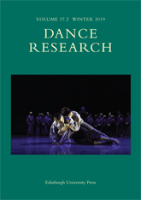
Dance Research
Celebrating Innovation in Dance ScholarshipDance Research is a prestigious academic journal published by Edinburgh University Press, dedicated to the comprehensive exploration of dance and its multifaceted interactions within the realms of visual arts and performing arts. Established in 1996, this journal has grown in prominence, achieving a Q1 ranking in the Visual Arts and Performing Arts category for 2023, signifying its influence and high-quality scholarship in the field. With an impressive Scopus ranking of #232 out of 667 in the Arts and Humanities cluster, it offers a vital platform for researchers, professionals, and students alike, facilitating critical discourse and innovative research on various aspects of dance. Although the journal currently operates under a traditional access model, its rich collection of articles often features diverse methodologies, in-depth case studies, and theoretical analyses that stimulate both academic inquiry and practical applications in dance. Dance Research is an essential resource for those looking to deepen their understanding of dance as an evolving art form, and is instrumental for advancing scholarly conversations in this vibrant field.

Quintana-Revista do Departamento de Historia da Arte
Fostering Critical Dialogue in the World of ArtQuintana-Revista do Departamento de Historia da Arte, published by the Universidade de Santiago de Compostela, is a distinguished academic journal that focuses on the critical analysis and exploration of visual arts and performing arts. With its ISSN 1579-7414 and E-ISSN 2340-0005, this journal serves as a vital platform for researchers, professionals, and students interested in the depth of art history and cultural discourse. Operating under a Q4 category in the realm of Visual Arts and Performing Arts, the journal is committed to fostering scholarly dialogue and advancing knowledge in the field. Though it currently does not offer open access options, it remains an invaluable resource for those aiming to contribute to and understand the evolving landscape of art history. The journal covers converged years from 2011 to 2012 and 2014 to 2024, highlighting its ongoing relevance and adaptability to contemporary discussions. As it continues to enhance its visibility and impact within the 20th percentile of its category according to Scopus rankings, Quintana invites contributions that deepen our understanding of artistic expression and cultural heritage.

Sala Preta
Unveiling Critical Perspectives in Modern MediaSala Preta is a distinguished academic journal published by UNIV SAO PAULO, ESCOLA COMUNICACOES & ARTES, dedicated to the exploration of communication and art in contemporary society. With its ISSN 2238-3867, this journal serves as an essential platform for researchers, professionals, and students to disseminate innovative research and critical analysis in the fields of visual arts, media studies, and cultural communication. Although not classified as Open Access, Sala Preta remains pivotal for fostering academic discourse, encouraging interdisciplinary collaboration, and advancing knowledge within its scope. Situated in the vibrant cultural landscape of São Paulo, Brazil, this journal signifies a commitment to high-quality scholarship that is both relevant and impactful in today's rapidly evolving digital and artistic contexts.

Architecture and Culture
Advancing Interdisciplinary Insights in Built EnvironmentsArchitecture and Culture is an esteemed journal published by Routledge Journals, Taylor & Francis Ltd, focusing on the intersection of architecture, cultural studies, urbanism, and the visual and performing arts. Since its inception, this journal has become a vital platform for researchers, professionals, and students to explore the multifaceted relationship between architecture and cultural identity within contemporary contexts. With an ISSN of 2050-7828 and an E-ISSN of 2050-7836, the journal reaches a global audience from its base in the United Kingdom. Featuring a commendable Q2 ranking in Visual Arts and Performing Arts and a consistent presence in multiple relevant quartiles, including Q3 in both Architecture and Cultural Studies, it is well-regarded for its scholarly impact. The journal offers a unique opportunity for interdisciplinary dialogue, fostering innovative research that examines how built environments shape and are shaped by cultural narratives. This commitment to advancing knowledge in these fields is reflected in its ongoing publication from 2014 to 2024, making it a pivotal resource for those at the forefront of the discourse on architecture and culture.
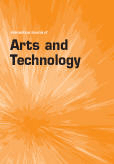
International Journal of Arts and Technology
Unveiling new frontiers in arts and technology.Welcome to the International Journal of Arts and Technology, a distinguished publication by InderScience Enterprises Ltd., based in Switzerland. With an ISSN of 1754-8853 and an E-ISSN of 1754-8861, this journal serves as a pivotal platform at the intersection of arts and technology. It aims to foster interdisciplinary research that explores innovative practices in Visual Arts and Performing Arts, as well as in the realm of Computer Science Applications. Recognized for its contributions with a Q2 ranking in Visual Arts and Performing Arts and a solid reputation in the Q4 tier of Computer Science Applications, the journal showcases high-caliber research with an impressive 88th percentile ranking in Arts and Humanities. Although not currently open access, the journal provides a unique avenue for professionals, researchers, and students eager to engage with contemporary findings and emerging trends that shape the future of art and technology. With publication provisions spanning from 2008 to 2017 and from 2019 to 2024, this journal promises to be a vital resource for anyone passionate about the continual evolution within these dynamic fields.

Fourth Genre-Explorations in Nonfiction
Engaging with the Rich Tapestry of Nonfiction WritingFourth Genre: Explorations in Nonfiction is a distinguished scholarly journal published by Michigan State University Press, dedicated to advancing the field of nonfiction literature. With its ISSN 1522-3868 and E-ISSN 1544-1733, this journal aims to foster innovative discourse and critical engagement with the diverse modalities of nonfiction writing. As part of its mission, Fourth Genre emphasizes the exploration of creative nonfiction as an art form and a medium for cultural expression, serving as a vital platform for both established and emerging voices in literary nonfiction. Despite its current categorization in Q4 in Literature and Literary Theory, the journal strives to elevate its impact and reach, creating a space for rigorous scholarship and creative practice. Researchers, professionals, and students interested in the intricate relationships between narrative form, factual content, and literary artistry will find this journal indispensable for their academic and creative pursuits. From its inception in 2010 to its convergence period extending to 2024, Fourth Genre continues to play a pivotal role in shaping discussions around the art of nonfiction storytelling.
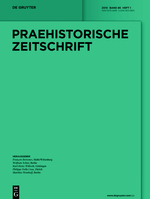
Praehistorische Zeitschrift
Unveiling the Past: Insights into Prehistoric ArchaeologyPraehistorische Zeitschrift is a premier scholarly journal dedicated to the field of archaeology, published by WALTER DE GRUYTER GMBH in Germany. With a rich history dating back to 1909, the journal has evolved to encompass a wide range of topics pertaining to prehistory, offering vital insights into archaeological practices, theories, and discoveries. Recognized as a Q1 journal in both the Archaeology category of Arts and Humanities and the Social Sciences, it holds a prestigious position with Scopus rankings placing it in the top 20% of its field. Although it operates under a traditional publishing model without open access, its comprehensive articles are essential reading for researchers, professionals, and students alike who seek to deepen their understanding of prehistoric studies through rigorous academic contributions. The journal continues to publish significant research from 1993 to 2024 and beyond, making it an indispensable resource for anyone interested in the archaeological narrative of humanity.